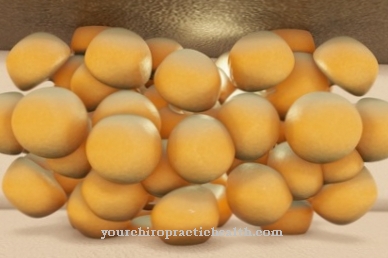With the ability to Light-dark adaptation the human eyes are able to adapt to the light conditions. There are two opposing processes of the visual system. Disorders of light-dark adaptation can occur in the case of vitamin A deficiency and after damage to the central nervous visual tract.
What is the light-dark adaptation?

Man is one of the eye-controlled living beings. This means that, from an evolutionary perspective, visual perception played the most important role in survival for him. Different adaptation processes take place in the eyes so that the human eye delivers a reliable image under permanently changing light conditions and viewing distances. One of them is light-dark adaptation, with which the eye adapts to different lighting conditions.
Light and dark adaptation are two different processes that run in opposite directions. The light adaptation is a special case of daytime vision. It is present when the visual system has adapted in its entirety to luminance levels above 3.4 cd per square meter. With dark adaptation, the visual system adapts to luminance levels of less than 0.034 cd per square meter.
When a person steps into a building from full sun, the visual environment appears almost black for a few seconds. Only a few minutes later is full adaptation achieved and the person recognizes details of the surroundings again. From this point on, she finds the view out of the window uncomfortable again, as the high luminance levels blind the dark-adapted eye. Dark adaptation is based on a resynthesis of the visual pigment in the cones and rods. In contrast, during light adaptation, the visual pigment disintegrates. For this reason, dark adaptation takes longer than light adaptation.
Function & task
The ability to adapt to light and dark adapts people's visual perception to the light conditions. The rods of the eye are more sensitive to light than the cones. In poor light conditions, the human eye therefore switches from cone vision to rod vision. The greatest density of cones is found in the fovea centralis. This place is the place of the sharpest vision, so that sharp vision is no longer possible in the dark and colors are poorly recognized.
The pupil adapts to the darkness through contractions of the dilatator pupillae muscle, so that more light falls into the eye. The rod sensitivity to light depends on the rhodopsin concentration.When it is bright, rhodopsin is required for transduction processes. With dark adaptation, the substance is no longer required for transduction and is accordingly available again in large quantities, which makes the eye more sensitive to light.
In addition, when the eye adapts to the dark, the lateral inhibition is reduced so that the center of receptive fields can expand into the periphery. Each ganglion cell receives receptive information from larger areas of the retina in the dark. The related spatial summation also increases the light sensitivity of the eyes.
The opposite changes take place in the light adaptation of the eyes. From the stick you switch to the cone sight so that the person can see sharp and colored again. In good light conditions, the pupils are narrowed by the parasympathetic sphincter pupillae muscle. The concentration of visual pigment drops and the eyes become less sensitive to light. At the same time, the receptive fields shrink.
The processes of light-dark adaptation often create optical illusions, for example in the form of successive contrast. Black and white patterns on a sheet of paper, for example, are seen as inverted patterns after a certain period of time.
You can find your medication here
➔ Medicines for visual disturbances and eye complaintsIllnesses & ailments
Different conditions can disrupt light-dark adaptation or change it pathologically. One of these conditions is vitamin deficiency. Above all, the chopsticks need vitamin A in order to function properly. The dark adaptation switches from cone vision to rod vision. This means that a person with a pronounced vitamin A deficiency can see poorly or not at all in the dark.
Since muscles are also involved in adjusting the pupil size and thus in both types of light-dark adaptation, paralysis can also be responsible for adaptation-related visual disturbances under certain circumstances. Both sympathetic and parasympathetic innervated muscles are required for light-dark adaptation. For this reason, lesions of nerve tissue in the sympathetic and parasympathetic nervous system can cause paralysis, which makes light-dark adaptation impossible. Such visual disturbances are neurogenic and are mostly related to degenerative diseases or other damage to the central nervous system.
Disturbances related to contrast sensitivity and color perception can also correspond to neurogenic disorders. The most common neurological cause in this context is a lesion of the nerve tissue in the area of the visual pathway. Such a nerve lesion can be due to different triggers. A traumatic brain injury may be a possible traumatic trigger. The visual pathway can also be damaged in the event of a stroke. This phenomenon refers to a sudden circulatory disorder in the brain that causes a regional lack of oxygen and nutrients. The insufficiently supplied tissue dies due to the deficiency symptoms.
As part of the autoimmune disease multiple sclerosis, different areas of the nerve tissue of the central nervous system can be damaged. Autoimmunological inflammatory reactions, which can destroy the tissue, are responsible for the damage. An inflammatory lesion in the area of the visual pathways can also lead to difficulties in light-dark adaptation.
Not only autoimmune inflammation, but also inflammatory reactions to bacterial infections are causally conceivable. In addition, tumor diseases or tumor metastases in the brain can cause problems with light-dark vision if they are in the area of visual perception or directly on the visual pathway.



























